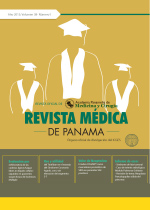Características clínicas e imagenológicas de los pacientes con úlcera por pie diabético con tratamiento endovascular de la enfermedad periférica arterial. C.H.M.DR.A.A.M. Marzo 2015 - junio 2017.
Autores/as
DOI:
https://doi.org/10.37980/im.journal.rmdp.2017772Resumen
RESUMEN
Introducción: La Diabetes mellitus es un problema global, y junto a sus
complicaciones representa la causa líder de muerte por enfermedades no transmisibles. El 50% de los pacientes con Diabetes presentan signos de compromiso vascular que al complicarse ameritan tratamiento con bypass quirúrgico que es el método convencional, pero se ha visto que la técnica endovascular ha ayudado a disminuir la morbilidad y la mortalidad de estos pacientes, reduciendo además, el número de amputaciones mayores en los pacientes con pie diabético y enfermedad arterial periférica
Objetivo: Describir características clínicas e imagenológicas de pacientes diabéticos con tratamiento endovascular de la enfermedad periférica arterial.
Metodología: Estudio descriptivo retrospectivo mediante revisión de expedientes clínicos y radiológicos. Utilizando un formulario para la recolección de datos y EpiInfo v7.2 para la creación y análisis la base de datos.
Resultados: Participaron 50 pacientes, el 52% pertenecían al sexo femenino, la mayoría de los pacientes pertenecían al grupo de los 61-70 años. La hipertensión arterial fue la comorbilidad más frecuente (78%). La enfermedad arterial por debajo de la rodilla fue la más observada, con afectación de la arteria tibial anterior principalmente (84%). La angioplastia con balón se realizó en el 100% de los casos, con falló en el 8% de los casos.
Conclusión: La enfermedad arterial periférica afecta en mayor medida a los vasos de la pierna por debajo de la rodilla. El tratamiento endovascular de las lesiones arteriales periféricas constituye un método con una gran tasa de éxito en el procedimiento inicial.
Palabas clave: diabetes mellitus, enfermedad arterial periférica, arteria tibial anterior, stent.
ABSTRACT
Objective: Describe the clinical and imaging characteristics of diabetic patients who underwent endovascular treatment for peripheral arterial disease.
Method: A retrospective descriptive study was carried out. We reviewed the data
in the clinical and radiological file of the patients included in the study, they were
collected in a survey sheet previously authorized by the Bioethics Committee of
the Institution. The data obtained were tabulated in the EpiInfo v7.2 program and graphed using the Office Excel 2016 program.
Results: Fifty patients who met the inclusion criteria were included in the study,
52% of them were women, mainly in the age group between 61-70 years. Arterial
hypertension was the most frequent comorbidity in the study population with 78%
of the total patients. Arterial disease below the knee was more frequent, with
involvement of the anterior tibial artery in 84% of the patients evaluated. Balloon angioplasty was performed in 100% of the cases, while stent placement wasnecessary in 10% of the procedures performed. The result of the procedure was not successful only in 4/50 patients performed. 84% of the patients presented primary patency at 6 months of evaluation.
Conclusion: Peripheral arterial disease mainly the vessels of the leg below the
knee. Endovascular treatment of peripheral arterial injuries is a safe method with a high success rate in the initial procedure, as well as a low recurrence of intervention at least 6 months after the procedure.
Key words: diabetes mellitus, peripheral arterial disease, anterior tibial artery,
stent.
Descargas
Publicado
Número
Sección
Licencia
Derechos autoriales y de reproducibilidad. La Revista Médica de Panama es un ente académico, sin fines de lucro, que forma parte de la Academia Panameña de Medicina y Cirugía. Sus publicaciones son de tipo acceso gratuito de su contenido para uso individual y académico, sin restricción. Los derechos autoriales de cada artículo son retenidos por sus autores. Al Publicar en la Revista, el autor otorga Licencia permanente, exclusiva, e irrevocable a la Sociedad para la edición del manuscrito, y otorga a la empresa editorial, Infomedic International Licencia de uso de distribución, indexación y comercial exclusiva, permanente e irrevocable de su contenido y para la generación de productos y servicios derivados del mismo. En caso que el autor obtenga la licencia CC BY, el artículo y sus derivados son de libre acceso y distribución.






